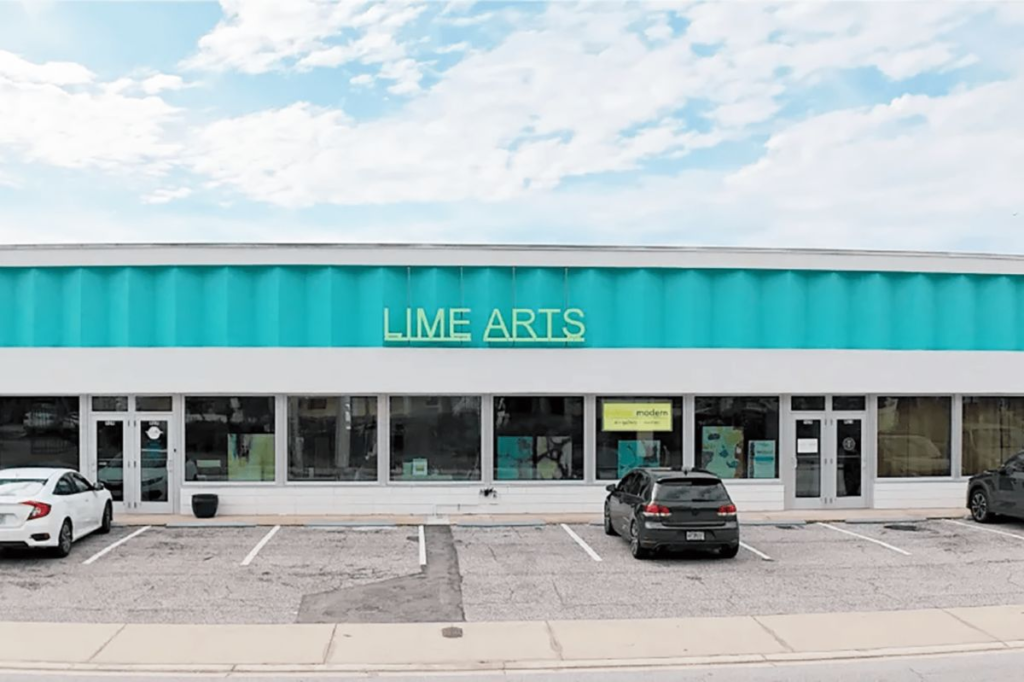
Local developer Howard Davis bought the building at 925 N. Lime Ave. in Sarasota in 2022 for $1,318,400.
The Lime Arts building, a creative hub in Sarasota’s emerging Limelight District, recently sold for $2.9 million to local investors Lauren and Dustin Dixon. The 10,000-square-foot property, which provides studio space for local artists and creatives and is a teal-colored symbol of the ongoing growth of the Limelight District, was sold by local developer Howard Davis.
Loosely defined as the area along North Lime Avenue, the Limelight District— which has made a name for itself thanks to locals like Kim Livengood, who owns and operates the indie market The Bazaar on Apricot & Lime, is one of the city’s up-and-coming areas. It’s home to more than 100 independent businesses.
Davis is known for his respectful work on urban properties in the area, especially the award-winning BOTA Center in the Rosemary District. His work on BOTA, which had been neglected and boarded up for almost 10 years, was recognized by the Florida Trust for Historic Preservation, which awarded Davis an award for Outstanding Achievement for Adaptive Use in 2018. He purchased the Lime Arts building in 2022 and invested heavily in its restoration.

Interior of the Lime Arts Building.

The Lime Arts building is home to local artists and makers.
Lauren Dixon, a Sarasota native and commercial realtor with Ian Black Real Estate, represented herself and her husband in the purchase. “The charm of this building is remarkable,” she says. “It’s part of our vision as a couple to support the local community and create a positive environment for creative minds. We were drawn to its unique architecture and the sense of community it offers.” Dixon, who’s a mom, says she also digs the monthly family days at Creative Liberties.
Currently, the Lime Arts building is home to four tenants: Pennenga Creative, Palmer Modern Art Gallery + Studios, Creative Liberties and public radio station WUSF. Davis’ renovation of the property included significant updates, like a new roof, HVAC system, energy-efficient windows, and insulated roll-up doors designed for easy access to large-scale art projects.
“I’m not a long-term landlord,” Davis says of his decision to sell. “I like to be a catalyst and work some magic with these buildings. My goal was to find buyers who would appreciate the tenants and maintain the status quo. After talking to several buyers who were more interested in return on investment, I met Lauren and Dustin and knew they were the right fit.”
Davis, who moved to Sarasota after spending more than 30 years in Boston developing large mixed-use projects, has focused his efforts here on smaller, infill, commercial buildings in close-knit, urban neighborhoods. “I’ve been doing this for 40 years,” he says. “I started with a tired building [BOTA] with great bones and turned it into a space where creatives could thrive. That’s the same approach I took with the Lime Arts building.”
“BOTA was an experiment that turned out to be a success and was filled with creatives, as planned,” he continues. “I ran it for two years and sold it, and it’s really the predecessor for the Lime Arts building. I was on the board of Art Center Sarasota and came to understand artists’ need for affordable space after being pushed out by increasing rents. After some time, the Rosemary District no longer had the same tired buildings with great bones which is where I like to start.”
The Dixons took note of the meticulous updates and see the building as an attraction in the Limelight District, which is gaining a reputation as “the new Rosemary District.” The purchase marks the couple’s first foray into commercial real estate ownership, and they plan to continue expanding their portfolio while maintaining a focus on community engagement and philanthropy.
“Our goal is to purchase one to two properties a year, provided the opportunity aligns with our values,” Lauren Dixon says. “We’re excited to support the thriving local businesses and bring more attention to the Limelight District.”
Davis says artists discovered the areas that became the Rosemary and Limelight districts at about the same time, but the two neighborhoods took different paths. Instead of big new construction projects, the Limelight District is working with existing buildings, many of which have been there for decades.
Despite the sale, Davis remains committed to the Limelight District, where he has had an office and woodworking shop for nearly a decade. “The Limelight District has a special energy,” he says. “I’m taking a breather, but it will continue to grow organically with the renovation of these smaller, more accessible buildings.”

